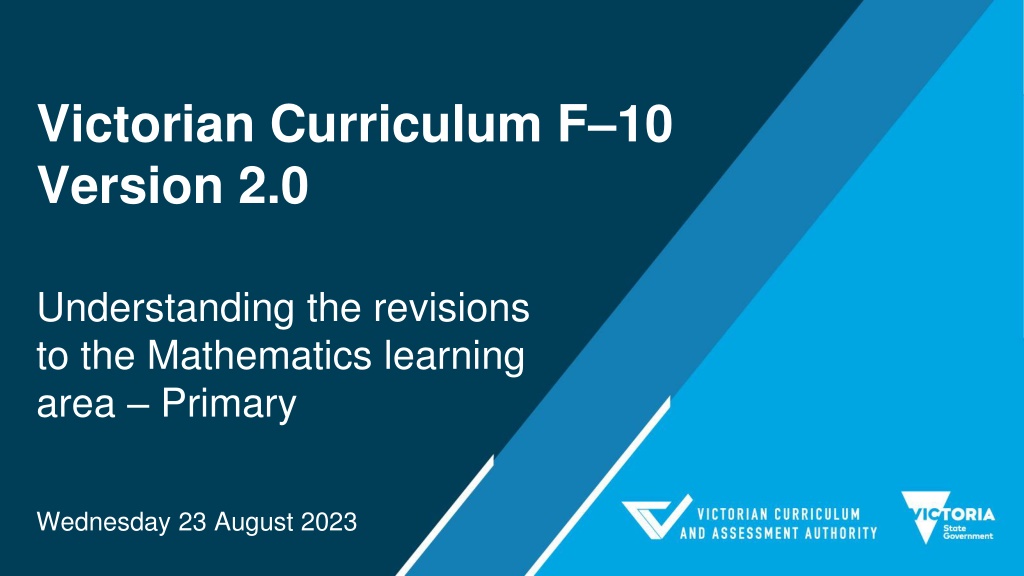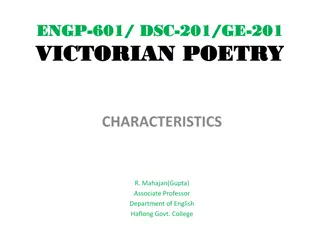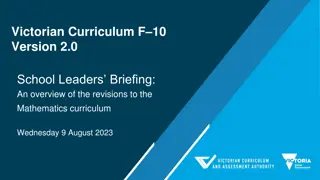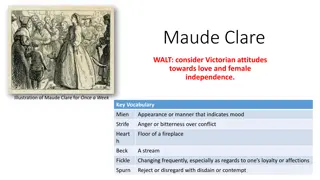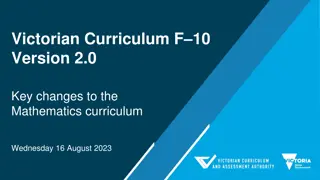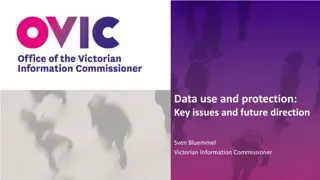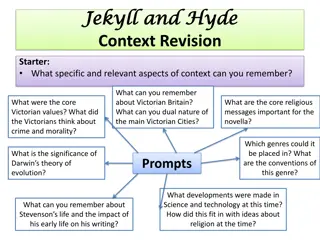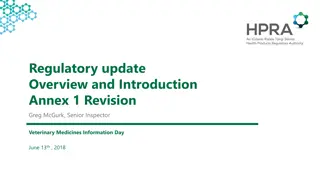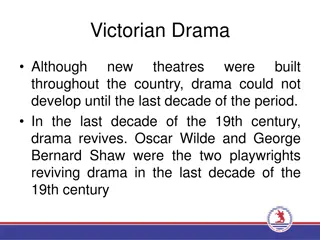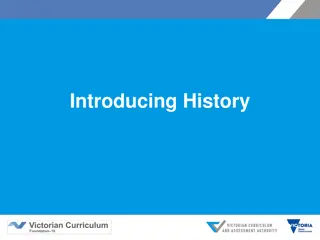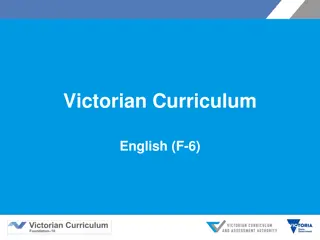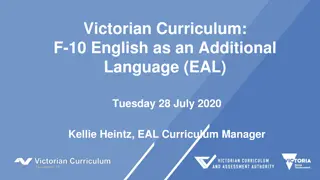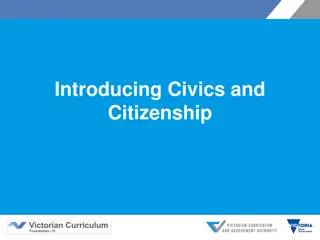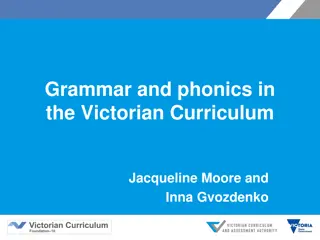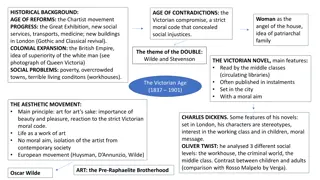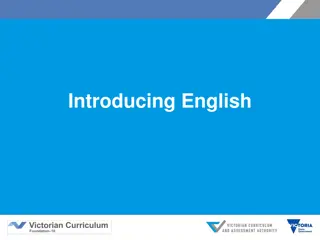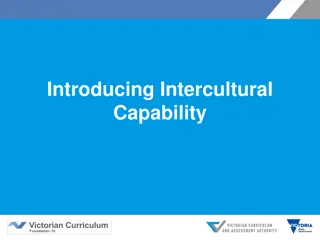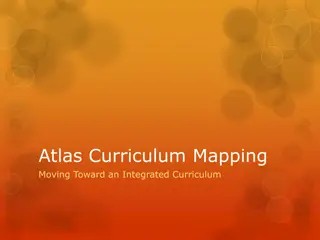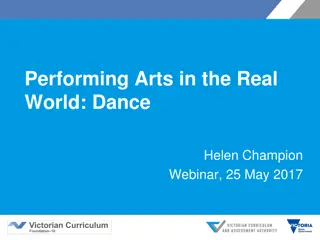Victorian Curriculum F-10 Version 2.0 Revision Overview
The Victorian Curriculum F-10 is undergoing revisions, with a focus on the Mathematics learning area for primary education. The curriculum acknowledges the traditional custodians of the land and aims to provide high-quality teaching resources aligned with Victorian standards. The VCAA, a statutory authority, is responsible for developing and evaluating curriculum and assessment products. The objectives include maintaining Victorian priorities, supporting teachers, and implementing a user-friendly digital platform.
Download Presentation

Please find below an Image/Link to download the presentation.
The content on the website is provided AS IS for your information and personal use only. It may not be sold, licensed, or shared on other websites without obtaining consent from the author.If you encounter any issues during the download, it is possible that the publisher has removed the file from their server.
You are allowed to download the files provided on this website for personal or commercial use, subject to the condition that they are used lawfully. All files are the property of their respective owners.
The content on the website is provided AS IS for your information and personal use only. It may not be sold, licensed, or shared on other websites without obtaining consent from the author.
E N D
Presentation Transcript
Victorian Curriculum F10 Version 2.0 Understanding the revisions to the Mathematics learning area Primary Wednesday 23 August 2023
Revising the Victorian Curriculum F10 Acknowledgment of Country I would like to acknowledge the traditional custodians of the many lands across Victoria on which each of you are living, learning and working from today. For myself and those of us in the Melbourne metropolitan area, we acknowledge the traditional custodians of the Kulin Nations. When acknowledging Country, we recognise Aboriginal and Torres Strait Islander Peoples spiritual and cultural connection to Country/Place and acknowledge their continued care of the lands and waterways over generations, while celebrating the continuation of a living culture that has a unique role in this region. I would like to pay my respects to Elders past, present and emerging, for they hold the memories, traditions, culture and hopes of all Aboriginal and Torres Strait Islander Peoples across the nation, and hope they will walk with us on our journey.
Overview 1. Overview of the revision and familiarisation of the Victorian Curriculum F 10 project Jason Smallwood Executive Director, Curriculum Division, VCAA 2 Revisions to the Mathematics learning area Primary Michael MacNeill Curriculum Manager, Mathematics, VCAA 3. Familiarisation (primary) Leyna Buller Senior Policy and Strategic Advisor (F 10 Revision), VCAA 4. Questions Panel
The VCAA is a statutory authority primarily accountable to the Minister for Education, serving both government and non-government schools designs, develops and evaluates curriculum and assessment products and services develops and implements the following curriculums and assessment: o Victorian Early Years Learning and Development Framework: Birth to 8 years o Early Years assessment o Victorian F 10 curriculum o Victorian F 10 assessment o Senior Secondary curriculum and assessment (VCE, VM, VPC) In the context of the VCAA: curriculum means the course design, including content, support materials and other learning resources. Reporting and pedagogy sit outside the remit of the VCAA. These are sector authority responsibilities.
Objectives alignment with the Victorian Early Years Learning and Development Framework 1 2 5 6 maintaining Victorian priorities and standards provide senior secondary pathways more teachable and manageable 7 3 familiarisation and support resources that support Victorian teachers improve achievement standards 8 4 a high-quality curriculum that teachers can implement with confidence a digital platform for the curriculum that is fit for purpose, accessible and user-friendly
What has not changed? Overarching structure of the Victorian Curriculum F 10 will not change Current learning areas, capabilities and cross-curriculum priorities will remain Recognises the continuing importance of a discipline-based approach to learning Continue to offer EAL and Levels A D curriculum. These are to be revised shortly and incorporated into the Victorian Curriculum F 10 Version 2.0 in late 2024 (dates to be confirmed)
Reporting Reporting requirements are set by the sector authorities All Victorian government and Catholic schools are required to provide written reports on student achievement against the Victorian Curriculum F 10 achievement standards for every student at least twice per year The Victorian Curriculum F 10 Version 2.0 will include revisions to the achievement standards to provide clarity and show progression Specific information can be found by contacting the: Department of Education Catholic Education Victoria Network
Implementation timeline Phased implementation from 2024 onwards Victorian Curriculum F 10 Mathematics Version 2.0 published on 28 July 2023 Victorian government and Catholic schools can implement from 2024, with full implementation in 2025 Implementation in independent schools is at the discretion of each school in the sector 2022 2023 2024 2025 Familiarisation Full Implementation Revision Familiarisation Mathematics Start Implementation
Victorian Curriculum F10 Mathematics Version 2.0 Revisions to the Mathematics learning area Primary Michael MacNeill Curriculum Manager, Mathematics, VCAA
Introducing Mathematics Version 2.0 High-level overview of the Victorian Curriculum F 10 Mathematics Version 2.0 Quick facts Key considerations Key changes Pages - Mathematics Version 2.0 (vcaa.vic.edu.au)
Structural revisions overview The Mathematics curriculum introduction material: Rationale, Aims, Learning In Content now organised under 6 strands Level descriptions greater detail about the content, skills and expected outcomes at each level Achievement standards clearer articulation, progression and connection to content descriptions Content descriptions clearer articulation of the essential mathematical facts, procedures and skills Elaborations more examples to empower teachers to engage with the content
Levels F6 key revisions There are only 5 content strands at Foundation to Level 2 with Probability commencing at Level 3 to permit consolidation of foundational counting and abstract engagement strategies (numerals, fractions, time) Greater emphasis on mathematical modelling and statistical investigation Increased prominence of computational and algorithmic thinking Content re-sequenced to provide students opportunity to consolidate and master key skills (e.g. time to half hour) Some content descriptions have been combined to strengthen connections in sequencing and add clarity to the content expectations
Mathematics Version 2.0 Rationale Aims Structure Learning In Mathematics Understanding Mathematics Version 2.0 Meeting diverse needs of learners Mathematical proficiencies Mathematical processes Curriculum (F 10) Level Descriptions Achievement standards Content descriptions Curriculum supporting resources Comparison of curriculums document Scope and sequence Glossary https://victoriancurriculum.vcaa.vic.edu.au/mathematics/mathematics-version-2-0/curriculum/f-10
Mathematics Version 2.0: Aims develop useful mathematical and numeracy skills for everyday life and work, as emerging active and critical citizens in a technological world become confident, proficient, effective and adaptive users of mathematics become effective communicators of mathematics who can investigate, represent and interpret situations in their personal and work lives, think critically, and make choices as active, engaged, numerate citizens develop proficiency with mathematical concepts, skills, procedures and processes, and use them to demonstrate mastery in mathematics as they pose and solve problems, and reason with number, algebra, measurement, space, statistics and probability
Mathematics Version 2.0: Aims make connections between areas of mathematics and apply mathematics to model situations in various fields and disciplines develop a positive disposition towards mathematics, recognising it as an accessible and useful discipline to study appreciate mathematics as a discipline its history, ideas, problems and applications, aesthetics and philosophy
The 6 strands 6 strands Number Algebra Measurement Space Statistics Probability The dual-strands have been decoupled now 6 individual strands Teachers can continue to use the familiar connections between strand content and can also now explore new connections across different strand pairings For example, teachers may choose to connect content from the Number and Space strands, or the Algebra and Measurement strands, when designing teaching and learning units
Connecting content across strands Level 3 Number Algebra Unit outline example (extract) add and subtract two- and three-digit numbers using place value to partition, rearrange and regroup numbers to assist in calculations without a calculator VC2M3N04 recognise and explain the connection between addition and subtraction as inverse operations, apply to partition numbers and find unknown values in number sentences VC2M3A01 part-whole strategy applying place value (adding and subtracting multiples of ten, within 100 and then beyond 100) place-value based strategy to add without renaming tens and ones place-value based strategy to subtract without renaming tens and ones place-value based strategy to add with renaming tens and ones place-value based strategy to subtract with renaming tens and ones Content description They partition, rearrange and regroup two- and three- digit numbers in different ways to assist in calculations. Students find unknown values in number sentences involving addition and subtraction. Achievement standard extract
Alignment: Content descriptions and achievement standards Current Mathematics curriculum Level 4 Patterns and algebra Use equivalent number sentences involving addition and subtraction to find unknown quantities VCMNA163 Mathematics Version 2.0 Level 4 Algebra Find unknown values in numerical equations involving addition and subtraction, using the properties of numbers and operations VC2M4A01 Students find unknown values in numerical equations involving addition and subtraction Content description Achievement standard (extract) Students identify unknown quantities in number sentences
Achievement Standard: Continuum of learning Implications for designing assessment Strand Level 1 Level 2 Level 3 students connect number names, numerals and quantities, and order numbers to at least 120. students order and represent numbers to at least 1000 students order and represent natural numbers beyond 10 000 Number Students compare and order objects and events based on the attributes of length, mass, capacity and duration, communicating their reasoning Students use uniform informal units to measure and compare shapes and objects. Students use familiar metric units when estimating, comparing and measuring the attributes of objects and events. Measurement
Scope and sequence Mathematical concepts are developmentally organised Considers the progression of learning within a strand Includes content descriptions and achievement standards Mathematics Version 2.0 - Scope and Sequence - Victorian Curriculum (vcaa.vic.edu.au)
Scope and sequence: Statistics Level 5 Level 6 Level 7 Level 8 Content descriptions acquire, validate and represent data for nominal and ordinal categorical and discrete numerical variables to address a question of interest or purpose using software including spreadsheets; discuss and report on data distributions in terms of highest frequency (mode) and shape, in the context of the data VC2M5ST01 interpret and compare data sets for ordinal and nominal categorical, discrete and continuous numerical variables using comparative displays or visualisations and digital tools; compare distributions in terms of mode, range and shape VC2M6ST01 acquire data sets for discrete and continuous numerical variables and calculate the range, median, mean and mode; make and justify decisions about which measures of central tendency provide useful insights into the nature of the distribution of data VC2M7ST01 distinguish between a population and a sample, and investigate techniques for data collection including census, sampling, experiment and observation, and explain the practicalities and implications of obtaining data through these techniques VC2M8ST01
Interwoven Mathematical processes Proficiencies of Understanding, Fluency, Reasoning and Problem- solving more clearly written into the content Content descriptions better encapsulate and articulate the scope of mathematical facts and associated procedures clearer for teachers Skills students need for future-facing educational needs closer connections with digital tools The key skills, vital for embedded learning, of mathematical modelling and statistical investigations feature more prominently, helping students to connect concepts with real-world experiences
Mathematical proficiencies The proficiencies are fundamental to learning mathematics and working mathematically The proficiencies are developed across the 6 strands They are the what and how of mathematics in action They enable students to respond to familiar and unfamiliar situations, make informed decisions, and adopt reflective approaches to verify and evaluate solutions Fluency Strands Understanding Reasoning Problem- solving
Proficiencies in content descriptions Content description clarity has been improved so that content descriptions more clearly articulate the proficiencies. Current Mathematics curriculum Level 4 Number and Algebra Recall multiplication facts up to 10 10 and related division facts (VCMNA155) Mathematics Version 2.0 Level 4 Algebra Use mathematical modelling to solve practical problems involving additive situations, including simple money transactions; represent the situations with diagrams, physical and virtual materials; use calculation strategies to solve the problem VC2M1N05 Investigate number sequences involving multiples of 3, 4, 6, 7, 8, and 9 (VCMNA154) Proficiencies: Understanding, Fluency, Reasoning, Problem solving
Computational thinking Decomposition Break down the problem into simpler, less complex components Pattern recognition Classify patterns in data and organising data logically Representation and interpretation Abstraction Remove non-essential information and focus on principal structure only Algorithms A sequence of instructions that can be performed Computational Thinking in the Victorian Curriculum (vcaa.vic.edu.au)
Mathematical modelling Level 3 Number example Content description Elaboration use mathematical modelling to solve practical problems involving additive and multiplicative situations, including financial contexts; formulate problems using number sentences and choose calculation strategies, using digital tools where appropriate; interpret and communicate solutions in terms of the situation VC2M3N08 modelling practical multiplicative situations using materials or a diagram to represent the problem; for example, if 4 tomato plants each have 6 tomatoes, deciding whether to use an addition or multiplication number sentence, explaining how each number in their number sentence is connected to the situation Develop Real-world or theoretical context mathematical model or formulate problem Apply mathematical model or use problem-solving strategies and techniques Interpret results and refine model or problem and approaches A simple cyclic scheme where real-life problems are translated into mathematical language
Mathematical modelling Research costs and expenses Level 6 Number example Content description Plan a family holiday or class excursion Use mathematical modelling to solve practical problems involving additive and multiplicative situations, including simple financial planning contexts; formulate the problems, choosing operations and efficient mental and written calculation strategies, and using digital tools where appropriate; interpret and communicate solutions in terms of the situation VC2M5N09 Represent budget in spreadsheet Use formulas to calculate totals
Statistical investigations Collect data Level 5 Statistics example Content description plan and conduct statistical investigations by posing questions or identifying a problem and collecting relevant data; choose appropriate displays and interpret the data; communicate findings within the context of the investigation VC2M5ST03 Question: What insect diversity do we have in the playground? Observe types and numbers of insects Interpret data and communicate findings
Mathematics: Comparison of curriculums document Comparison of the current Victorian Curriculum F 10 Mathematics and the Victorian Curriculum F 10 Mathematics Version 2.0 Provides concise commentary on the changes that have occurred in the achievement standards and content descriptions Can be used to initially assess the scale of impact on teaching and learning units https://www.vcaa.vic.edu.au/curriculum/foundation-10/resources/mathematics/Pages/MathematicsVersion2_0.aspx
Content consolidated Foundation: VC2 strand: Statistics Victorian Curriculum F 10 Version 1.0 Organise answers to yes/no questions into simple data displays using objects and drawings (VCMSP084) Interpret simple data displays about yes/no questions (VCMSP085) Answer yes/no questions to collect information (VCMSP083) Victorian Curriculum F 10 Version 2.0 collect, sort and compare data represented by objects and images in response to given investigative questions that have only 2 outcomes and relate to familiar situations Comment Content descriptions consolidated into VC2MFST01 to facilitate connections in sequencing VC2MFST01 Sort and classify familiar objects and explain the basis for these classifications, and copy, continue and create patterns with objects and drawings (VCMNA076)
New content Level 3: VC2 strand: Probability Victorian Curriculum F 10 Version 1.0 Victorian Curriculum F 10 Version 2.0 conduct repeated chance experiments to observe relationships between outcomes in games and other chance situations, and identify and describe the variation in results VC2M4P02 Comment New content description
Removed to reduce duplication E.g. Level 5: VC2 strand: Space Victorian Curriculum F 10 Version 1.0 Apply the enlargement transformation to familiar two dimensional shapes and explore the properties of the resulting image compared with the original (VCMMG201) Victorian Curriculum F 10 Version 2.0 Comment Removed to reduce duplication
Content realigned up levels Level 5: VC2 strand: Measurement Victorian Curriculum F 10 Version 1.0 Choose appropriate units of measurement for length, area, volume, capacity and mass (VCMMG195) Victorian Curriculum F 10 Version 2.0 choose appropriate metric units when measuring the length, mass and capacity of objects; use smaller units or a combination of units to obtain a more accurate measure VC2M5M01 Comment Refined and realigned from Level 4 Measurement and Geometry
Content realigned down levels Level 2: VC2 strand: Algebra Victorian Curriculum F 10 Version 1.0 Describe patterns with numbers and identify missing elements (VCMNA112) Describe, continue, and create number patterns resulting from performing addition or subtraction (VCMNA138) Victorian Curriculum F 10 Version 2.0 recognise, describe and create additive patterns that increase or decrease by a constant amount, using numbers, shapes and objects, and identify missing elements in the pattern VC2M2A01 Comment Combined and realigned from Level 3 Number and Algebra Implementation year content moved down a level (for example, from Level 3 to Level 2) It will need to be covered at both levels in the first year of implementation
Realignment of content down levels Level/Strand Content description Version 2.0 Change from Version 1.0 Implications Level 1 Number quantify sets of objects, to at least 120, by partitioning collections into equal groups using number knowledge and skip counting VC2M1N03 Content combined and realigned from Level 2 Number and Algebra. During implementation year, content will need to be covered at Levels 1 and 2 Level 1 Algebra recognise, continue and create pattern sequences, with numbers, symbols, shapes and objects including Australian coins, formed by skip counting, initially by twos, fives and tens VC2M1A01 Content realigned from Level 2 Number and Algebra During implementation year, content will need to be covered at Levels 1 and 2 Level 2 Algebra recognise, describe and create additive patterns that increase or decrease by a constant amount, using numbers, shapes and objects, and identify missing elements in the pattern VC2M2A01 Combined and realigned from Level 3 Number and Algebra During implementation year, content will need to be covered at Levels 2 and 3 recall and demonstrate proficiency with addition facts to 20; extend and apply facts to develop related subtraction facts VC2M2A02 Realigned from Level 3 Number and Algebra During implementation year, content will need to be covered at Levels 2 and 3 Level 2 Algebra recognise, represent and order natural numbers using naming and writing conventions for numerals beyond 10 000VC2M3N02 Combined and realigned from Levels 4 and 5 Number and Algebra During implementation year, content will need to be covered at Levels 3 and some content at Levels 4 and 5 Level 3 Number recognise that 100% represents the complete whole and use percentages to describe, represent and compare relative size; connect familiar percentages to their decimal and fraction equivalents VC2M5N04 Split and realigned from Level 6 Number and Algebra During implementation year, content will need to be covered at Level 5 and Level 6 Level 5 Number Level 6 Algebra find unknown values in numerical equations involving brackets and combinations of arithmetic operations, using the properties of numbers and operations VC2M6A02 Combined and realigned from Level 7 Number and Algebra During implementation year, content will need to be covered at Level 6 and Level 7 locate points in the 4 quadrants of the Cartesian plane; describe changes to the coordinates when a point is moved to a different position in the plane VC2M6SP02 Combined and realigned from Level 7 Number and Algebra During implementation year, content will need to be covered at Level 6 and Level 7 Level 6 Space
Content realignment The following slides have been included as a resource for teachers. The slides show where content has been realigned across Foundation to Level 6. Note: At Foundation Level, a slide has not been included, as content has either been refined for clarity, combined and refined or split and refined. Refer to the 'comparison of curriculums' document for more detail at each level. https://www.vcaa.vic.edu.au/curriculum/foundation-10/resources/mathematics/Pages/MathematicsVersion2_0.aspx
Realignment of content Level 1 Level/Strand Content Description Version 2.0 Change from Version 1.0 Implications Level 1 Number quantify sets of objects, to at least 120, by partitioning collections into equal groups using number knowledge and skip counting VC2M1N03 Content combined and realigned from Level 2 Number and Algebra. During implementation year, content will need to be covered at Levels 1 and 2 partition one- and two-digit numbers in different ways using physical and virtual materials, including partitioning two-digit numbers into tens and ones VC2M1N02 Level 1 Number N/A New content to be covered at Level 1 3 new Content Descriptions use mathematical modelling to solve practical problems involving additive situations, including simple money transactions; represent the situations with diagrams, physical and virtual materials; use calculation strategies to solve the problem VC2M1N05 use mathematical modelling to solve practical problems involving equal sharing and grouping; represent the situations with diagrams, physical and virtual materials, and use calculation strategies to solve the problem VC2M1N06 Level 1 Algebra recognise, continue and create pattern sequences, with numbers, symbols, shapes and objects including Australian coins, formed by skip counting, initially by twos, fives and tens VC2M1A01 Content realigned from Level 2 Number and Algebra During implementation year, content will need to be covered at Levels 1 and 2 Level 1 N/A Probability content removed and realigned to Level 3 Probability content not covered at Level 1
Realignment of content Level 2 Level/Strand Content Description Version 2.0 Change from Version 1.0 Implications recognise and describe one-half as one of 2 equal parts of a whole and connect halves, quarters and eighths through repeated halving VC2M2N03 Level 2 Number Realigned from Level 1 Number and Algebra Content now to be covered at Level 2 Level 2 Algebra recognise, describe and create additive patterns that increase or decrease by a constant amount, using numbers, shapes and objects, and identify missing elements in the pattern VC2M2A01 Combined and realigned from Level 3 Number and Algebra During implementation year, content will need to be covered at Levels 2 and 3 recall and demonstrate proficiency with addition facts to 20; extend and apply facts to develop related subtraction facts VC2M2A02 During implementation year, content will need to be covered at Levels 2 and 3 Level 2 Algebra Realigned from Level 3 Number and Algebra recall and demonstrate proficiency with multiplication facts for twos; extend and apply facts to develop the related division facts using doubling and halving VC2M2A03 Level 2 Algebra N/A New content to be covered at Level 2 1 new Content Description recognise and read the time represented on an analog clock to the hour, half-hour and quarter hour VC2M2M04 Level 2 Measurement Realigned form Level 1 Measurement and Geometry Content now to be covered at Level 2 Level 2 N/A Probability content removed and realigned to Level 3 Probability content not covered at Level 2
Realignment of content Level 3 Level/Strand Content Description Version 2.0 Change from Version 1.0 Implications recognise, represent and order natural numbers using naming and writing conventions for numerals beyond 10 000 VC2M3N02 During implementation year, content will need to be covered at Levels 3 and some of the content at Levels 4 and 5 Level 3 Number Combined and realigned from Levels 4 and 5 Number and Algebra Level 3 Number estimate the quantity of objects in collections and make estimates when solving problems to determine the reasonableness of calculations VC2M3N06 N/A New content to be covered at Level 3 2 new Content Descriptions follow and create algorithms involving a sequence of steps and decisions to investigate numbers; describe any emerging patterns VC2M3N09 recognise and explain the connection between addition and subtraction as inverse operations, apply to partition numbers and find unknown values in number sentences VC2M3A01 Level 3 Algebra Combined and realigned from Level 2 Number and Content now to be covered at Level 3 Algebra make, compare and classify objects, identifying key features and explaining why these features make them suited to their uses VC2M3SP01 identify practical activities and everyday events that involve chance, and describe possible outcomes and events as likely or unlikely and identify some events as certain or impossible , explaining reasoning VC2M3P01 Combined and realigned from Level 2 Measurement and Geometry Level 3 Space Content now to be covered at Level 3 Level 3 Probability Refined and realigned from Levels 1 and 2 Probability Content now to be covered at Level 3 and Statistics
Realignment of content Level 4 Level/Strand Content Description Version 2.0 Change from Version 1.0 Implications solve problems involving multiplying or dividing natural numbers by multiples and powers of 10 without a calculator, using the multiplicative relationship between the place value of digits VC2M4N05 Level 4 Number N/A New content to be covered at Level 4 1 new Content Description Level 4 Number follow and create algorithms involving a sequence of steps and decisions that use addition or multiplication to generate sets of numbers; identify and describe any emerging patterns VC2M4N10 Combined, refined and realigned from Level 3 Number and Algebra Content now to be covered at Level 4 conduct repeated chance experiments to observe relationships between outcomes in games and other chance situations, and identify and describe the variation in results VC2M4P02 Level 4 Probability N/A New content to be covered at Level 4 1 new Content Description
Realignment of content Level 5 Level/Strand Content Description Version 2.0 Change from Version 1.0 Implications recognise that 100% represents the complete whole and use percentages to describe, represent and compare relative size; connect familiar percentages to their decimal and fraction equivalents VC2M5N04 During implementation year, content will need to be covered at Level 5 and Level 6 Level 5 Number Split and realigned from Level 6 Number and Algebra Level 5 Algebra recognise and explain the connection between multiplication and division as inverse operations and use this to develop families of number facts VC2M5A01 N/A New content to be covered at Level 5 1 new Content Description choose appropriate metric units when measuring the length, mass and capacity of objects; use smaller units or a combination of units to obtain a more accurate measure VC2M5M01 Refined and realigned from Level 4 Measurement and Geometry Level 5 Measurement Content now to be covered at Level 5 interpret line graphs representing change over time; discuss the relationships that are represented and conclusions that can be made VC2M5ST02 Level 5 Statistics N/A New content to be covered at Level 5 1 new Content Description conduct repeated chance experiments, including those with and without equally likely outcomes, and observe and record the results; use frequency to compare outcomes and estimate their likelihoods VC2M5P02 Level 5 Probability N/A New content to be covered at Level 5 1 new Content Description
Realignment of content Level 6 Level/Strand Content Description Version 2.0 Change from Version 1.0 Implications N/A Connect volume and capacity and their units of measurement (VCMMG225) Realigned to Level 8 Measurement the concept too challenging for Level 6 Level 6 Level 6 Algebra find unknown values in numerical equations involving brackets and combinations of arithmetic operations, using the properties of numbers and operations VC2M6A02 Combined and realigned from Level 7 Number and Algebra During implementation year, content will need to be covered at Level 6 and Level 7 locate points in the 4 quadrants of the Cartesian plane; describe changes to the coordinates when a point is moved to a different position in the plane VC2M6SP02 During implementation year, content will need to be covered at Level 6 and Level 7 Level 6 Space Combined and realigned from Level 7 Number and Algebra describe probabilities using fractions, decimals and percentages; recognise that probabilities lie on numerical scales of 0 1 or 0% 100%; use estimation to assign probabilities that events occur in a given context, using common fractions, percentages and decimals VC2M6P01 Combined and realigned from Level 5 Statistics and Probability Level 6 Probability Content now covered at Level 5
Victorian Curriculum F10 Mathematics Version 2.0 Familiarisation Leyna Buller Senior Policy and Strategic Advisor (F 10 Revision), VCAA
Mathematics familiarisation: Modules Audience Curriculum Area Leader (Mathematics) Primary Understanding the learning area Primary Teacher (Mathematics) Understanding the learning area Chapter 1 Changes to the learning area Using the continuum of learning in the achievement standards to plan assessment programs Mapping mathematical concepts across levels Unique features of the learning area: Understanding and applying mathematical concepts in teaching, learning and assessing Approaches to designing a teaching and learning program across levels using the curriculum Chapter 2 Chapter 3 Using achievement standards to design assessment tasks Designing a teaching and learning unit Chapter 4 Chapter 5 Approaches to designing a teaching and learning program within a level Chapter 6
Mathematics familiarisation: Support materials Artefact Glossary Scope and sequence documents Comparison of curriculums document Introducing Mathematics Version 2.0 Exemplar approaches to assessment using the revised achievement standards Curriculum Area Maps: Mathematics templates for schools to populate, and exemplars provided for Levels 3 and 8 Curriculum Area Plan: templates for schools to populate and Mathematics exemplars provided for F 6 and 7 10 Teaching and learning unit by learning area/discipline and year level: templates for schools to populate and Mathematics exemplars for units in Levels 3 and 8 Mathematics leaders guide how to support teachers and schools to update their teaching and learning programs. Includes descriptions of how to engage with the whole-school curriculum planning templates Mathematics teachers guide how to update to update their teaching and learning programs Term 3 Term 4
Digital Assessment Library The Digital Assessment Library (DAL) delivers free, high-quality online classroom assessments, providing teachers with meaningful and timely information about student learning and progress. All assessments are directly aligned to the Victorian Curriculum F 10. The DAL contains over 137 Mathematics assessments. The VCAA is progressively releasing assessments that align with and support the implementation of the revised curriculum. You can find out more about the DAL via the VCAA website.
Links For information on the familiarisation of Mathematics Version 2.0, including supporting resources and registration for webinars VCAA website Mathematics Version 2.0 For Mathematics Version 2.0 curriculum Victorian Curriculum F 10 website Mathematics Version 2.0 For general information about the Victorian Curriculum F 10 Revision VCAA website Victorian Curriculum F 10 Version 2.0
Subscribe to the F10 Curriculum update https://www.vcaa.vic.edu.au/Footer/Pages/Subscribe.aspx
Contact Victorian Curriculum F 10 Revision Project tel: 03 7022 1306 email: vcaa.f10.revisionproject@education.vic.gov.au
